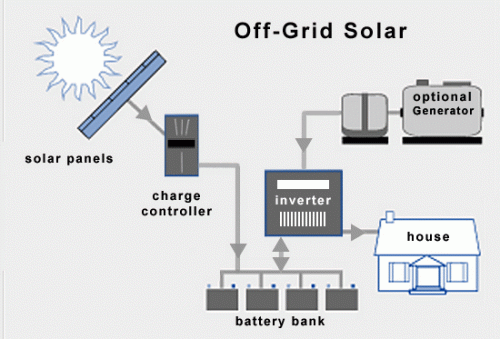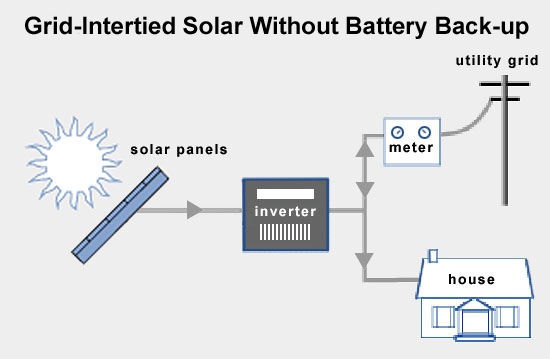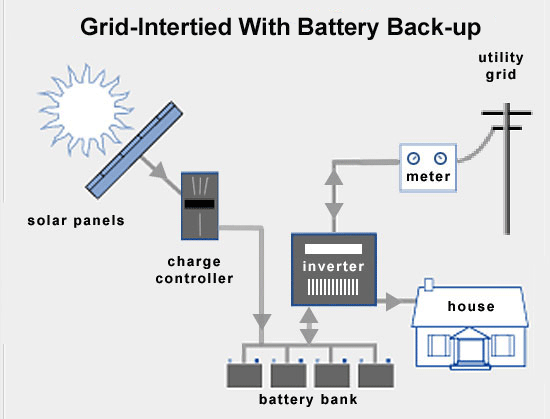[A] PV Direct System
These are the simple most of solar PV systems, with the fewest components : the Solar Panels and the load. Because they don’t have batteries and are not hooked up to the grid, they only power the loads when the sun is shining. They are appropriate for a few applications e.g. water pumping or attic ventilation fan.
[B] Off-Grid System 
Also referred to as stand-alone systems, it is designed to be independent of the power grid. Batteries are used to store energy when the sun is not an available during cloudy days or at night. This type of system will require regular attention to battery electrolyte levels and terminal corrosion.
- Independence from the utility grid
- Not subject to the terms/policies of the utility company
- Rate increases, blackouts, or brownouts do not apply
- In remote areas, it is cost effective than extending a grid
- Encourages energy efficiency
- Batteries require maintenance and has limited life
- More components means more complexity
- Batteries decrease system efficiency
- It is more expensive than a grid-direct system
- When the batteries are fully charged, potential power from the PV array is not utilized
- If the PV system fails, back-up electricity is required to run load
- Most off-grid systems use a backup generator for non-sunny days. They are expensive, noisy, dirty, and require fuel and regular maintenance
[C] Grid Tied System 
These are most common type of PV systems. They are also known as on-grid, grid-tied, grid-intertied, or grid-direct systems. They generate solar electricity and route it to the loads and to the grid, offsetting some of electricity usage. System components comprised of the PV array and inverter. Grid-connected system is similar to regular electric powered system except that some or all of the electricity comes from the sun. The drawback of these batteryless systems is that they provide no outage protection—when the utility grid fails, these systems cannot operate.)
- grid-tied-system
- Increased design flexibility because the system does not have to power all of the home’s loads
- It is less expensive compared to stand-alone or grid-tied with battery backup systems
- It requires the least amount of maintenance
- If the system produces more than the loads need, then the extra energy is exchanged with the utility grid
- Grid-direct systems have a higher efficiency because batteries are not part of the system
- Higher voltage means smaller wire size
- Electricity costs are fixed for the life of your system
- There is no power to the home when the grid goes down
- Paperwork requirements for interconnection, incentives, and rebates
[D] Grid-tied with battery-backup system 
This type is very similar to an off-grid system in design and components, but adds the utility grid, which reduces the need for the system to provide all the energy all the time.
- grid-tied-with-battery-backup
- Designated loads have power when the grid goes down
- If the system produces more than the home needs, then the extra energy is sold back to the utility- not lost as in a stand-alone systems after the batteries get full on a sunny day
- Batteries require maintenance
- Requires rewiring circuits from main service panel to a separate subpanel
- More components mean more complexityN
- Batteries decrease system performance because of their efficiency losses
- More expensive than a grid-direct system
- Typically only provides modest backup – usually not all of the loads are backed up
- Requires paperwork for interconnection, incentives, and rebates
[E] Hybrid system
Hybrid system tries to combine multiple sources of power to maximize availability of power. It may source energy from sun, wind or diesel generator and back it up with battery.
- Multiple sources of generation allows for complementary sources and backup. For instance, when it is sunny out the PV array will charge the battery; if it is cloudy and windy, a wind turbine can charge the batteries
- Array size and battery bank capacity can typically be reduced and not having to oversize for periods of no sun
- More complex system design and installation
- Multiple power sources can increase upfront expenses
- Wind turbines and generators require regular maintenance.
